BULAW5916 Taxation Law & Practice Assignment - Summer 2019/2020
VerifiedAdded on 2022/08/28
|10
|2515
|17
Homework Assignment
AI Summary
This assignment solution addresses key aspects of Australian taxation law. Part A examines the functions of taxation, the characteristics of a good tax system, and details on land tax, including its application in Victoria and New South Wales. Part B focuses on a proposed reformation, discussing changes to land tax and their implications for wealthy investors, affordable housing developers, and renters. It also analyzes the competitiveness of South Australia's tax rates. Part C delves into the Goods and Services Tax (GST) and its application to property sales, specifically addressing the obligations of a seller regarding notification and withholding of GST. The assignment provides a comprehensive overview of taxation principles and their practical application in the Australian context, referencing relevant legislation and case studies.
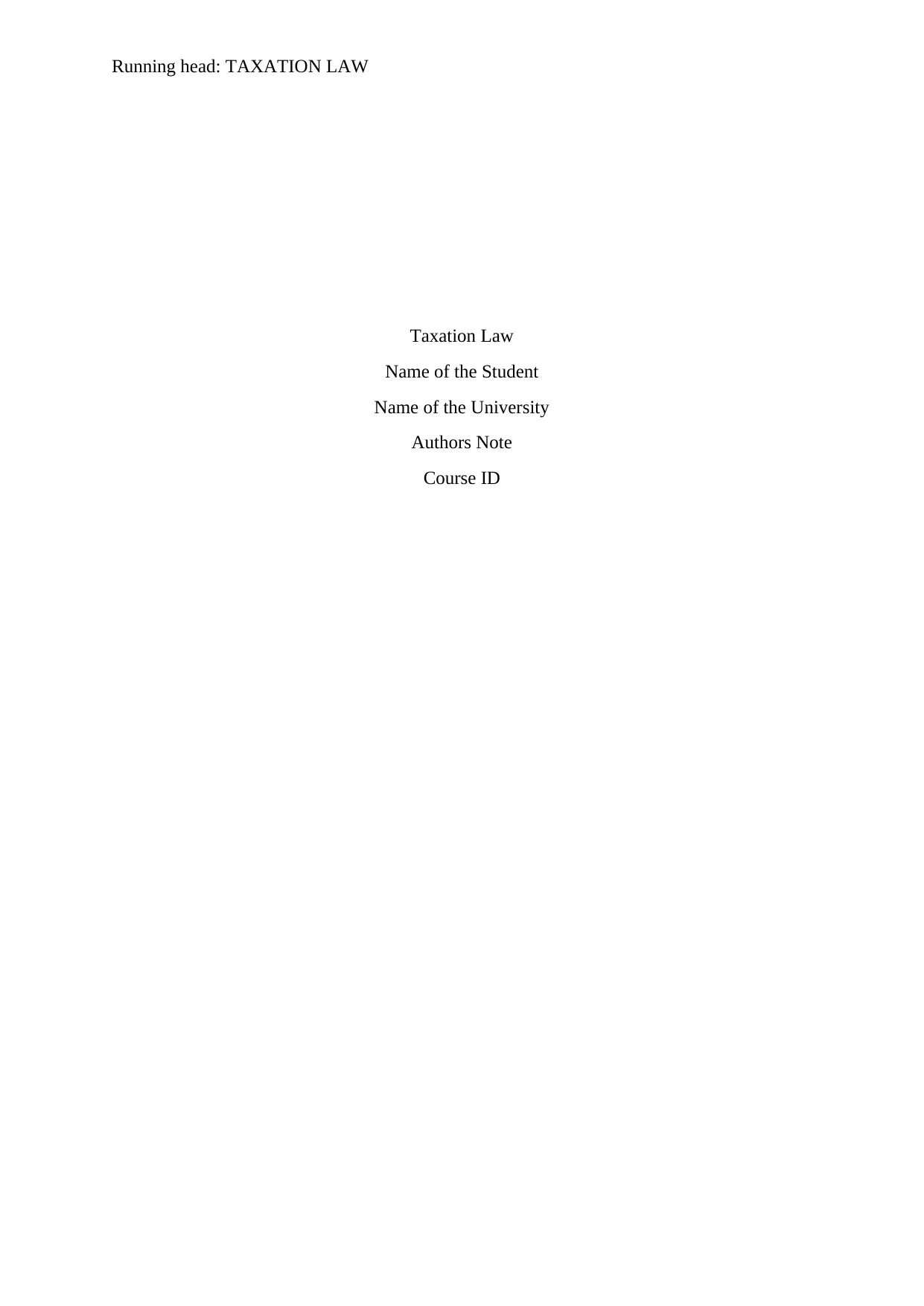
Running head: TAXATION LAW
Taxation Law
Name of the Student
Name of the University
Authors Note
Course ID
Taxation Law
Name of the Student
Name of the University
Authors Note
Course ID
Paraphrase This Document
Need a fresh take? Get an instant paraphrase of this document with our AI Paraphraser

1TAXATION LAW
Table of Contents
Answer to Part A:.......................................................................................................................3
Answer to Part B:.......................................................................................................................6
Answer to C................................................................................................................................8
References:.................................................................................................................................9
Table of Contents
Answer to Part A:.......................................................................................................................3
Answer to Part B:.......................................................................................................................6
Answer to C................................................................................................................................8
References:.................................................................................................................................9
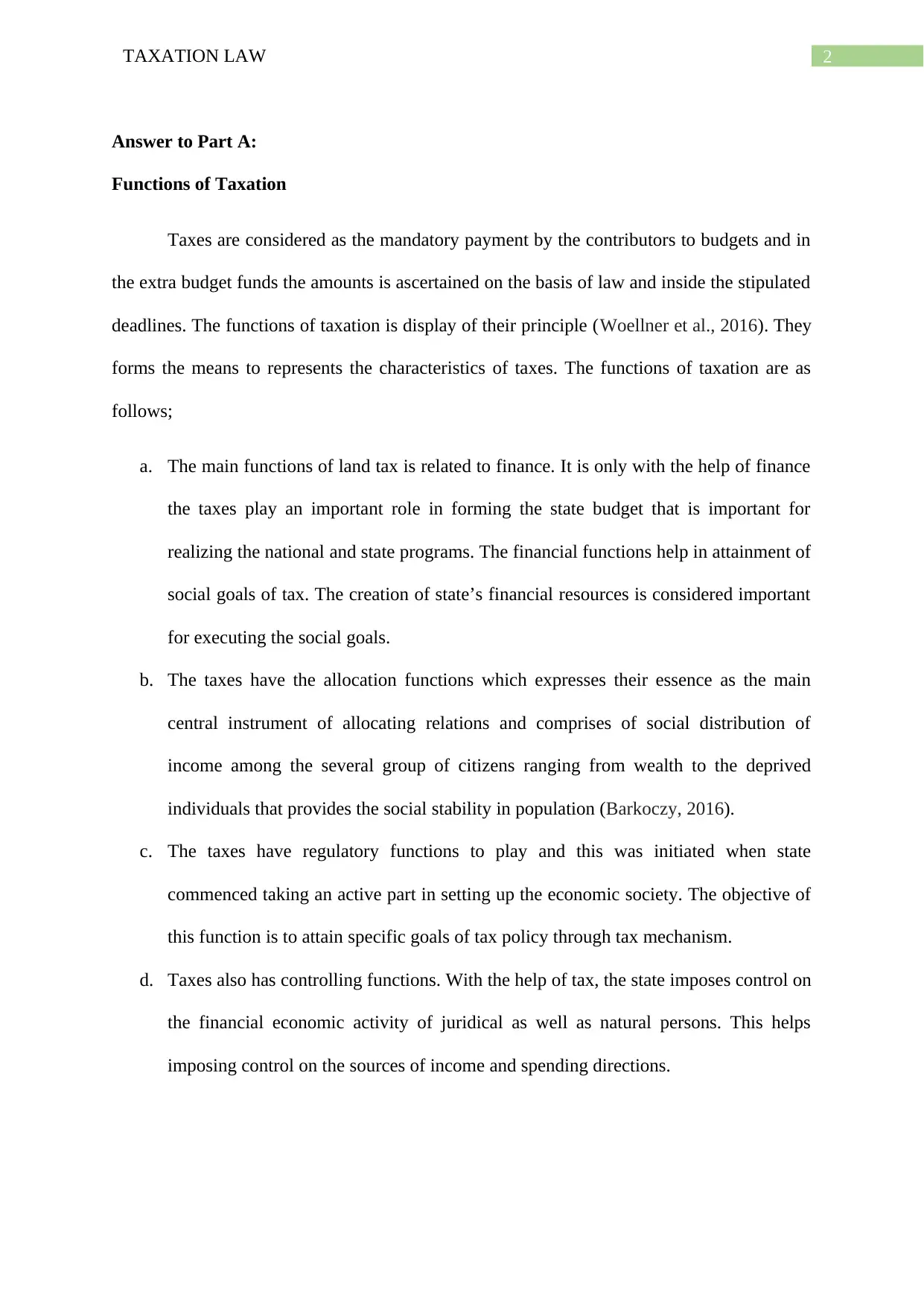
2TAXATION LAW
Answer to Part A:
Functions of Taxation
Taxes are considered as the mandatory payment by the contributors to budgets and in
the extra budget funds the amounts is ascertained on the basis of law and inside the stipulated
deadlines. The functions of taxation is display of their principle (Woellner et al., 2016). They
forms the means to represents the characteristics of taxes. The functions of taxation are as
follows;
a. The main functions of land tax is related to finance. It is only with the help of finance
the taxes play an important role in forming the state budget that is important for
realizing the national and state programs. The financial functions help in attainment of
social goals of tax. The creation of state’s financial resources is considered important
for executing the social goals.
b. The taxes have the allocation functions which expresses their essence as the main
central instrument of allocating relations and comprises of social distribution of
income among the several group of citizens ranging from wealth to the deprived
individuals that provides the social stability in population (Barkoczy, 2016).
c. The taxes have regulatory functions to play and this was initiated when state
commenced taking an active part in setting up the economic society. The objective of
this function is to attain specific goals of tax policy through tax mechanism.
d. Taxes also has controlling functions. With the help of tax, the state imposes control on
the financial economic activity of juridical as well as natural persons. This helps
imposing control on the sources of income and spending directions.
Answer to Part A:
Functions of Taxation
Taxes are considered as the mandatory payment by the contributors to budgets and in
the extra budget funds the amounts is ascertained on the basis of law and inside the stipulated
deadlines. The functions of taxation is display of their principle (Woellner et al., 2016). They
forms the means to represents the characteristics of taxes. The functions of taxation are as
follows;
a. The main functions of land tax is related to finance. It is only with the help of finance
the taxes play an important role in forming the state budget that is important for
realizing the national and state programs. The financial functions help in attainment of
social goals of tax. The creation of state’s financial resources is considered important
for executing the social goals.
b. The taxes have the allocation functions which expresses their essence as the main
central instrument of allocating relations and comprises of social distribution of
income among the several group of citizens ranging from wealth to the deprived
individuals that provides the social stability in population (Barkoczy, 2016).
c. The taxes have regulatory functions to play and this was initiated when state
commenced taking an active part in setting up the economic society. The objective of
this function is to attain specific goals of tax policy through tax mechanism.
d. Taxes also has controlling functions. With the help of tax, the state imposes control on
the financial economic activity of juridical as well as natural persons. This helps
imposing control on the sources of income and spending directions.
⊘ This is a preview!⊘
Do you want full access?
Subscribe today to unlock all pages.

Trusted by 1+ million students worldwide
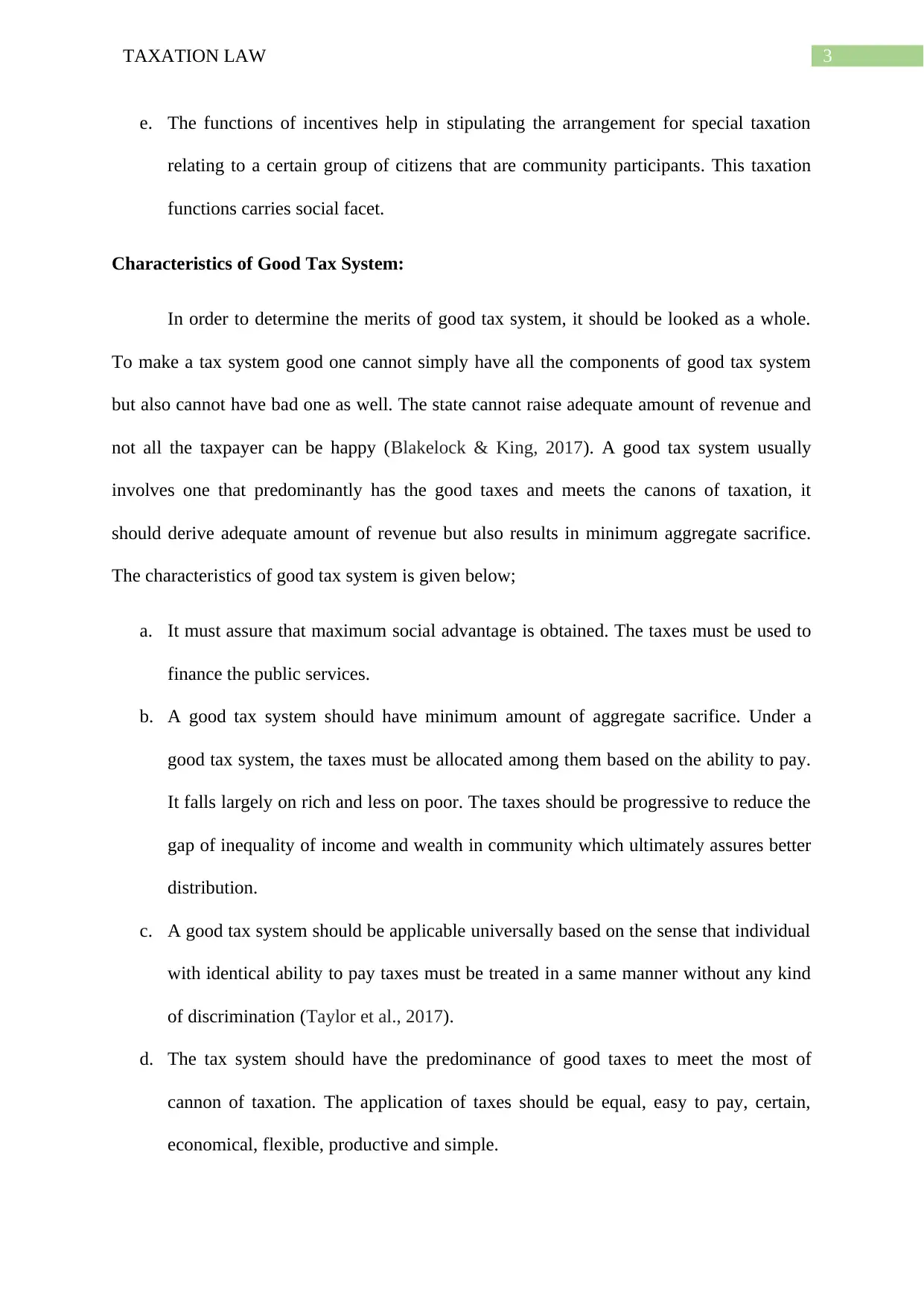
3TAXATION LAW
e. The functions of incentives help in stipulating the arrangement for special taxation
relating to a certain group of citizens that are community participants. This taxation
functions carries social facet.
Characteristics of Good Tax System:
In order to determine the merits of good tax system, it should be looked as a whole.
To make a tax system good one cannot simply have all the components of good tax system
but also cannot have bad one as well. The state cannot raise adequate amount of revenue and
not all the taxpayer can be happy (Blakelock & King, 2017). A good tax system usually
involves one that predominantly has the good taxes and meets the canons of taxation, it
should derive adequate amount of revenue but also results in minimum aggregate sacrifice.
The characteristics of good tax system is given below;
a. It must assure that maximum social advantage is obtained. The taxes must be used to
finance the public services.
b. A good tax system should have minimum amount of aggregate sacrifice. Under a
good tax system, the taxes must be allocated among them based on the ability to pay.
It falls largely on rich and less on poor. The taxes should be progressive to reduce the
gap of inequality of income and wealth in community which ultimately assures better
distribution.
c. A good tax system should be applicable universally based on the sense that individual
with identical ability to pay taxes must be treated in a same manner without any kind
of discrimination (Taylor et al., 2017).
d. The tax system should have the predominance of good taxes to meet the most of
cannon of taxation. The application of taxes should be equal, easy to pay, certain,
economical, flexible, productive and simple.
e. The functions of incentives help in stipulating the arrangement for special taxation
relating to a certain group of citizens that are community participants. This taxation
functions carries social facet.
Characteristics of Good Tax System:
In order to determine the merits of good tax system, it should be looked as a whole.
To make a tax system good one cannot simply have all the components of good tax system
but also cannot have bad one as well. The state cannot raise adequate amount of revenue and
not all the taxpayer can be happy (Blakelock & King, 2017). A good tax system usually
involves one that predominantly has the good taxes and meets the canons of taxation, it
should derive adequate amount of revenue but also results in minimum aggregate sacrifice.
The characteristics of good tax system is given below;
a. It must assure that maximum social advantage is obtained. The taxes must be used to
finance the public services.
b. A good tax system should have minimum amount of aggregate sacrifice. Under a
good tax system, the taxes must be allocated among them based on the ability to pay.
It falls largely on rich and less on poor. The taxes should be progressive to reduce the
gap of inequality of income and wealth in community which ultimately assures better
distribution.
c. A good tax system should be applicable universally based on the sense that individual
with identical ability to pay taxes must be treated in a same manner without any kind
of discrimination (Taylor et al., 2017).
d. The tax system should have the predominance of good taxes to meet the most of
cannon of taxation. The application of taxes should be equal, easy to pay, certain,
economical, flexible, productive and simple.
Paraphrase This Document
Need a fresh take? Get an instant paraphrase of this document with our AI Paraphraser
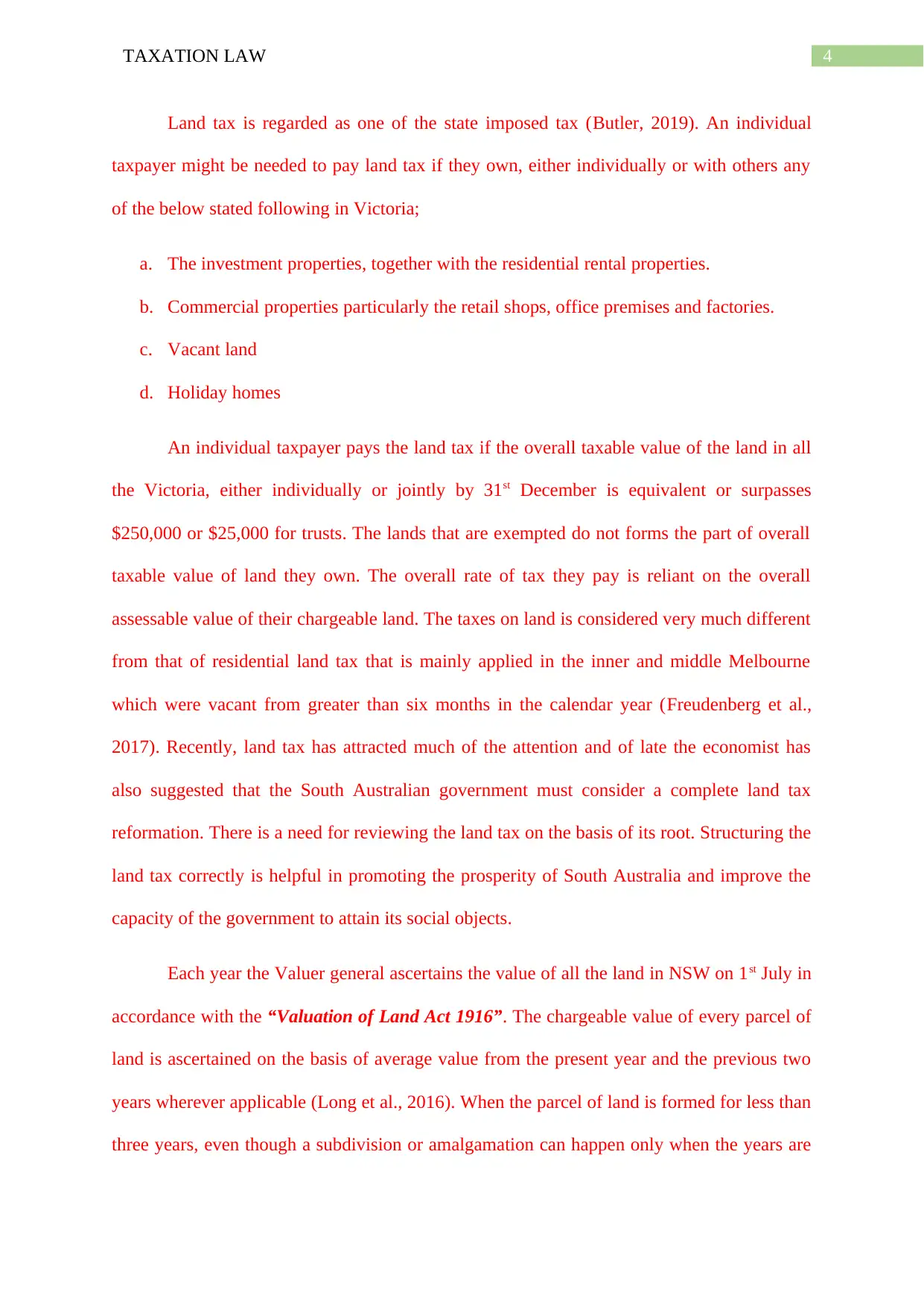
4TAXATION LAW
Land tax is regarded as one of the state imposed tax (Butler, 2019). An individual
taxpayer might be needed to pay land tax if they own, either individually or with others any
of the below stated following in Victoria;
a. The investment properties, together with the residential rental properties.
b. Commercial properties particularly the retail shops, office premises and factories.
c. Vacant land
d. Holiday homes
An individual taxpayer pays the land tax if the overall taxable value of the land in all
the Victoria, either individually or jointly by 31st December is equivalent or surpasses
$250,000 or $25,000 for trusts. The lands that are exempted do not forms the part of overall
taxable value of land they own. The overall rate of tax they pay is reliant on the overall
assessable value of their chargeable land. The taxes on land is considered very much different
from that of residential land tax that is mainly applied in the inner and middle Melbourne
which were vacant from greater than six months in the calendar year (Freudenberg et al.,
2017). Recently, land tax has attracted much of the attention and of late the economist has
also suggested that the South Australian government must consider a complete land tax
reformation. There is a need for reviewing the land tax on the basis of its root. Structuring the
land tax correctly is helpful in promoting the prosperity of South Australia and improve the
capacity of the government to attain its social objects.
Each year the Valuer general ascertains the value of all the land in NSW on 1st July in
accordance with the “Valuation of Land Act 1916”. The chargeable value of every parcel of
land is ascertained on the basis of average value from the present year and the previous two
years wherever applicable (Long et al., 2016). When the parcel of land is formed for less than
three years, even though a subdivision or amalgamation can happen only when the years are
Land tax is regarded as one of the state imposed tax (Butler, 2019). An individual
taxpayer might be needed to pay land tax if they own, either individually or with others any
of the below stated following in Victoria;
a. The investment properties, together with the residential rental properties.
b. Commercial properties particularly the retail shops, office premises and factories.
c. Vacant land
d. Holiday homes
An individual taxpayer pays the land tax if the overall taxable value of the land in all
the Victoria, either individually or jointly by 31st December is equivalent or surpasses
$250,000 or $25,000 for trusts. The lands that are exempted do not forms the part of overall
taxable value of land they own. The overall rate of tax they pay is reliant on the overall
assessable value of their chargeable land. The taxes on land is considered very much different
from that of residential land tax that is mainly applied in the inner and middle Melbourne
which were vacant from greater than six months in the calendar year (Freudenberg et al.,
2017). Recently, land tax has attracted much of the attention and of late the economist has
also suggested that the South Australian government must consider a complete land tax
reformation. There is a need for reviewing the land tax on the basis of its root. Structuring the
land tax correctly is helpful in promoting the prosperity of South Australia and improve the
capacity of the government to attain its social objects.
Each year the Valuer general ascertains the value of all the land in NSW on 1st July in
accordance with the “Valuation of Land Act 1916”. The chargeable value of every parcel of
land is ascertained on the basis of average value from the present year and the previous two
years wherever applicable (Long et al., 2016). When the parcel of land is formed for less than
three years, even though a subdivision or amalgamation can happen only when the years are
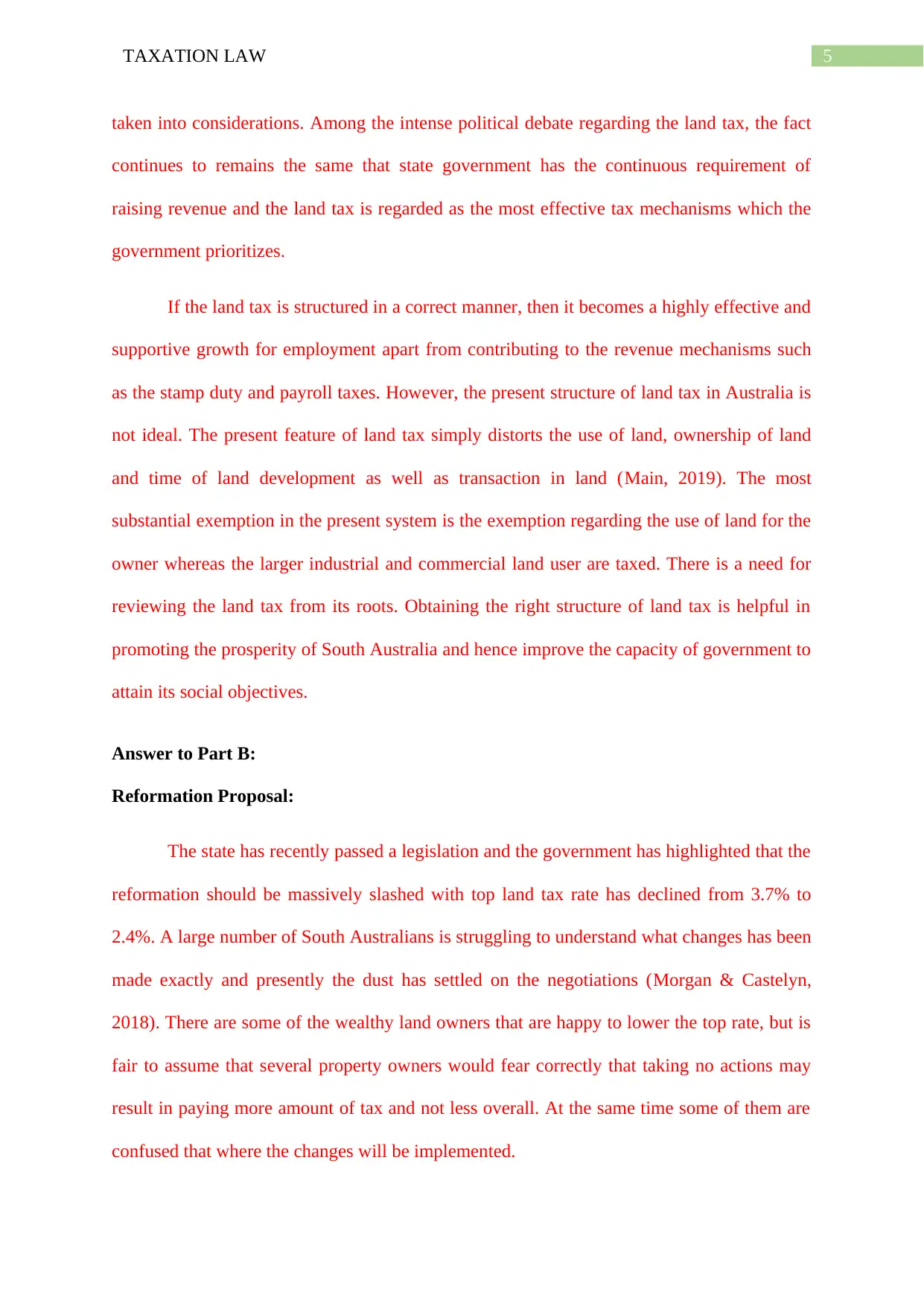
5TAXATION LAW
taken into considerations. Among the intense political debate regarding the land tax, the fact
continues to remains the same that state government has the continuous requirement of
raising revenue and the land tax is regarded as the most effective tax mechanisms which the
government prioritizes.
If the land tax is structured in a correct manner, then it becomes a highly effective and
supportive growth for employment apart from contributing to the revenue mechanisms such
as the stamp duty and payroll taxes. However, the present structure of land tax in Australia is
not ideal. The present feature of land tax simply distorts the use of land, ownership of land
and time of land development as well as transaction in land (Main, 2019). The most
substantial exemption in the present system is the exemption regarding the use of land for the
owner whereas the larger industrial and commercial land user are taxed. There is a need for
reviewing the land tax from its roots. Obtaining the right structure of land tax is helpful in
promoting the prosperity of South Australia and hence improve the capacity of government to
attain its social objectives.
Answer to Part B:
Reformation Proposal:
The state has recently passed a legislation and the government has highlighted that the
reformation should be massively slashed with top land tax rate has declined from 3.7% to
2.4%. A large number of South Australians is struggling to understand what changes has been
made exactly and presently the dust has settled on the negotiations (Morgan & Castelyn,
2018). There are some of the wealthy land owners that are happy to lower the top rate, but is
fair to assume that several property owners would fear correctly that taking no actions may
result in paying more amount of tax and not less overall. At the same time some of them are
confused that where the changes will be implemented.
taken into considerations. Among the intense political debate regarding the land tax, the fact
continues to remains the same that state government has the continuous requirement of
raising revenue and the land tax is regarded as the most effective tax mechanisms which the
government prioritizes.
If the land tax is structured in a correct manner, then it becomes a highly effective and
supportive growth for employment apart from contributing to the revenue mechanisms such
as the stamp duty and payroll taxes. However, the present structure of land tax in Australia is
not ideal. The present feature of land tax simply distorts the use of land, ownership of land
and time of land development as well as transaction in land (Main, 2019). The most
substantial exemption in the present system is the exemption regarding the use of land for the
owner whereas the larger industrial and commercial land user are taxed. There is a need for
reviewing the land tax from its roots. Obtaining the right structure of land tax is helpful in
promoting the prosperity of South Australia and hence improve the capacity of government to
attain its social objectives.
Answer to Part B:
Reformation Proposal:
The state has recently passed a legislation and the government has highlighted that the
reformation should be massively slashed with top land tax rate has declined from 3.7% to
2.4%. A large number of South Australians is struggling to understand what changes has been
made exactly and presently the dust has settled on the negotiations (Morgan & Castelyn,
2018). There are some of the wealthy land owners that are happy to lower the top rate, but is
fair to assume that several property owners would fear correctly that taking no actions may
result in paying more amount of tax and not less overall. At the same time some of them are
confused that where the changes will be implemented.
⊘ This is a preview!⊘
Do you want full access?
Subscribe today to unlock all pages.

Trusted by 1+ million students worldwide

6TAXATION LAW
The most important amendment that is proposed by these reformation is that wealthy
investors would not be able to use the distinct company and trust structures to avoid the
payment of land tax, which remains to be the critical feature of the bill that is passed as law.
The land tax overhaul has been through five separate changes ever since the first change is
announced during the budget of June, some made mollify the independent and minor parties
in the state parliament, while others for regaining the lost royalties from the industry applies.
The changes comprise of $25 million transition fund for the taxpayers and companies that are
hit by high bill of land tax under the new aggregation changes (Robin & Barkoczy, 2019).
This transition fund would operate for a period of three years and would offer the taxpayers
with the opportunity of restructuring their affairs over the time. There are also concessions
for the developers of affordable housing and new residential estates.
A recommendation can be made to state that there is one possibility of bringing all the
housing under the land tax at a flat rate. However, if the exemption of owner occupier
housing remains untouchable, the government must take into the account the measure of
extending the treatment to renters (Sadiq, 2019). The increasing schedule of rising tax on land
must be replaced with the flat rate. A wide base flat rate land tax should be implemented.
Even though it is not feasible politically it will be yet worthwhile to take into the account the
constructive reformations to the Australia’s present land tax.
There is also a question as how the development of land must be considered and
whether there are any kind of improvements on the present approach of levying a full year tax
bill on the basis of 30 June ownership. As the changes has left South Australia with the top
land tax rate higher than the NSW at 2 per cent and Victoria 2.25 per cent, it is less than the
Western Australia tax rate of 2.67 per cent and Queensland’s commercial property land tax at
a rate of 2.75 per cent (Taylor et al., 2017). The jury is out on whether this would create a
desire outcome of making the South Australia highly competitive. It may appear that while
The most important amendment that is proposed by these reformation is that wealthy
investors would not be able to use the distinct company and trust structures to avoid the
payment of land tax, which remains to be the critical feature of the bill that is passed as law.
The land tax overhaul has been through five separate changes ever since the first change is
announced during the budget of June, some made mollify the independent and minor parties
in the state parliament, while others for regaining the lost royalties from the industry applies.
The changes comprise of $25 million transition fund for the taxpayers and companies that are
hit by high bill of land tax under the new aggregation changes (Robin & Barkoczy, 2019).
This transition fund would operate for a period of three years and would offer the taxpayers
with the opportunity of restructuring their affairs over the time. There are also concessions
for the developers of affordable housing and new residential estates.
A recommendation can be made to state that there is one possibility of bringing all the
housing under the land tax at a flat rate. However, if the exemption of owner occupier
housing remains untouchable, the government must take into the account the measure of
extending the treatment to renters (Sadiq, 2019). The increasing schedule of rising tax on land
must be replaced with the flat rate. A wide base flat rate land tax should be implemented.
Even though it is not feasible politically it will be yet worthwhile to take into the account the
constructive reformations to the Australia’s present land tax.
There is also a question as how the development of land must be considered and
whether there are any kind of improvements on the present approach of levying a full year tax
bill on the basis of 30 June ownership. As the changes has left South Australia with the top
land tax rate higher than the NSW at 2 per cent and Victoria 2.25 per cent, it is less than the
Western Australia tax rate of 2.67 per cent and Queensland’s commercial property land tax at
a rate of 2.75 per cent (Taylor et al., 2017). The jury is out on whether this would create a
desire outcome of making the South Australia highly competitive. It may appear that while
Paraphrase This Document
Need a fresh take? Get an instant paraphrase of this document with our AI Paraphraser
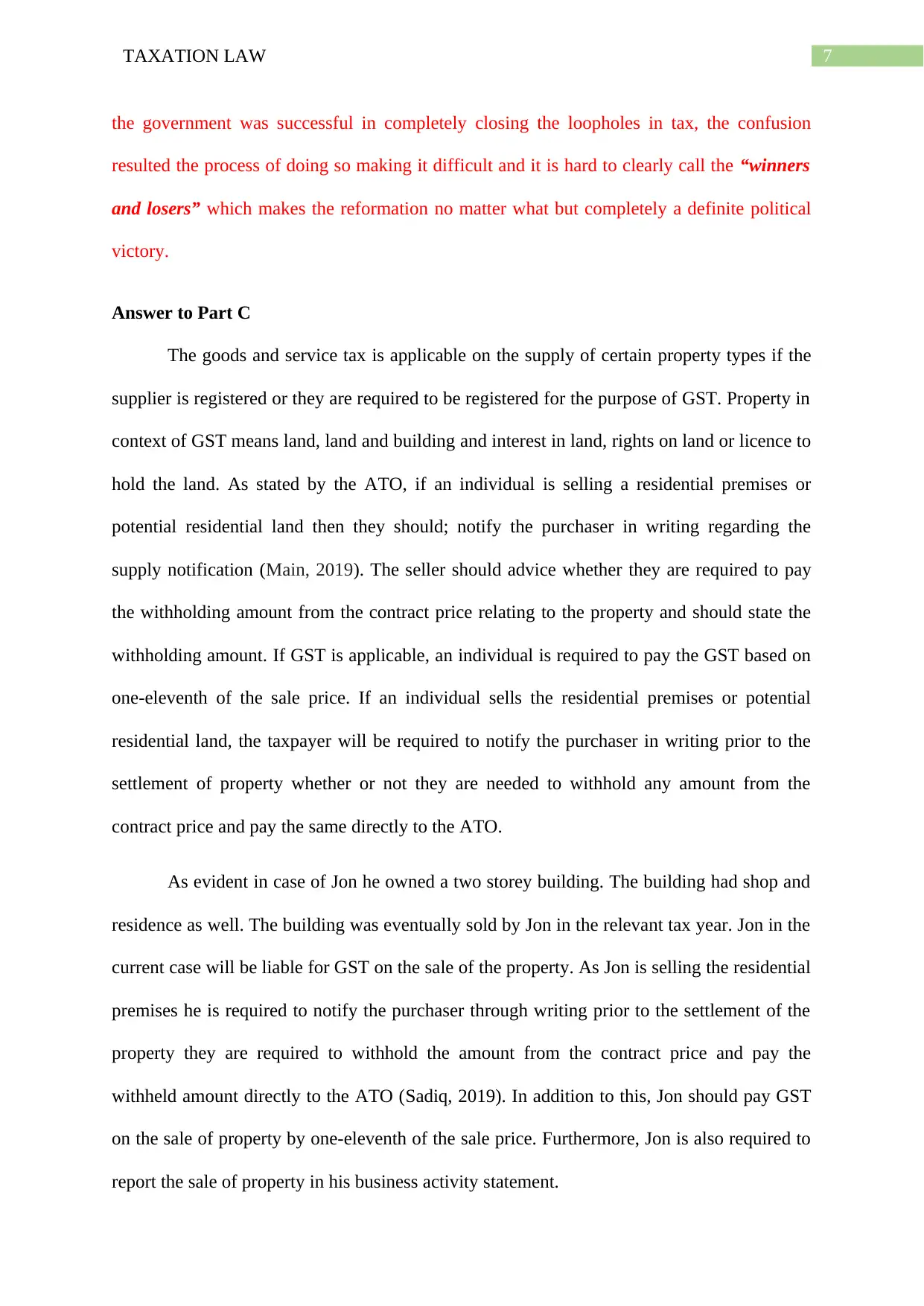
7TAXATION LAW
the government was successful in completely closing the loopholes in tax, the confusion
resulted the process of doing so making it difficult and it is hard to clearly call the “winners
and losers” which makes the reformation no matter what but completely a definite political
victory.
Answer to Part C
The goods and service tax is applicable on the supply of certain property types if the
supplier is registered or they are required to be registered for the purpose of GST. Property in
context of GST means land, land and building and interest in land, rights on land or licence to
hold the land. As stated by the ATO, if an individual is selling a residential premises or
potential residential land then they should; notify the purchaser in writing regarding the
supply notification (Main, 2019). The seller should advice whether they are required to pay
the withholding amount from the contract price relating to the property and should state the
withholding amount. If GST is applicable, an individual is required to pay the GST based on
one-eleventh of the sale price. If an individual sells the residential premises or potential
residential land, the taxpayer will be required to notify the purchaser in writing prior to the
settlement of property whether or not they are needed to withhold any amount from the
contract price and pay the same directly to the ATO.
As evident in case of Jon he owned a two storey building. The building had shop and
residence as well. The building was eventually sold by Jon in the relevant tax year. Jon in the
current case will be liable for GST on the sale of the property. As Jon is selling the residential
premises he is required to notify the purchaser through writing prior to the settlement of the
property they are required to withhold the amount from the contract price and pay the
withheld amount directly to the ATO (Sadiq, 2019). In addition to this, Jon should pay GST
on the sale of property by one-eleventh of the sale price. Furthermore, Jon is also required to
report the sale of property in his business activity statement.
the government was successful in completely closing the loopholes in tax, the confusion
resulted the process of doing so making it difficult and it is hard to clearly call the “winners
and losers” which makes the reformation no matter what but completely a definite political
victory.
Answer to Part C
The goods and service tax is applicable on the supply of certain property types if the
supplier is registered or they are required to be registered for the purpose of GST. Property in
context of GST means land, land and building and interest in land, rights on land or licence to
hold the land. As stated by the ATO, if an individual is selling a residential premises or
potential residential land then they should; notify the purchaser in writing regarding the
supply notification (Main, 2019). The seller should advice whether they are required to pay
the withholding amount from the contract price relating to the property and should state the
withholding amount. If GST is applicable, an individual is required to pay the GST based on
one-eleventh of the sale price. If an individual sells the residential premises or potential
residential land, the taxpayer will be required to notify the purchaser in writing prior to the
settlement of property whether or not they are needed to withhold any amount from the
contract price and pay the same directly to the ATO.
As evident in case of Jon he owned a two storey building. The building had shop and
residence as well. The building was eventually sold by Jon in the relevant tax year. Jon in the
current case will be liable for GST on the sale of the property. As Jon is selling the residential
premises he is required to notify the purchaser through writing prior to the settlement of the
property they are required to withhold the amount from the contract price and pay the
withheld amount directly to the ATO (Sadiq, 2019). In addition to this, Jon should pay GST
on the sale of property by one-eleventh of the sale price. Furthermore, Jon is also required to
report the sale of property in his business activity statement.

8TAXATION LAW
References:
Barkoczy, S. (2016). Foundations of taxation law 2016. OUP Catalogue.
Blakelock, S., & King, P. (2017). Taxation law: The advance of ATO data
matching. Proctor, The, 37(6), 18.
Butler, D. (2019). Who can provide taxation advice?. Taxation in Australia, 53(7), 381.
Freudenberg, B., Chardon, T., Brimble, M., & Isle, M. B. (2017). Tax literacy of Australian
small businesses. J. Austl. Tax'n, 19, 21.
Long, B., Campbell, J., & Kelshaw, C. (2016). The justice lens on taxation policy in
Australia. St Mark's Review, (235), 94.
Main, J. (2019). Taxation: Buying or selling: beware the sting of GST. LSJ: Law Society of
NSW Journal, (55), 73.
Morgan, A., & Castelyn, D. (2018). Taxation Education in Secondary Schools. J.
Australasian Tax Tchrs. Ass'n, 13, 307.
Morgan, A., Mortimer, C., & Pinto, D. (2018). A practical introduction to Australian
taxation law 2018. Oxford University Press.
ROBIN & BARKOCZY WOELLNER (STEPHEN & MURPHY, SHIRLEY ET AL.).
(2019). AUSTRALIAN TAXATION LAW SELECT 2019: Legislation and
Commentary. OXFORD University Press.
Sadiq, K. (2019). Australian Taxation Law Cases 2019. Thomson Reuters.
Taylor, J., Walpole, M., Burton, M., Ciro, T., & Murray, I. (2017). Understanding Taxation
Law 2018. LexisNexis Butterworths.
References:
Barkoczy, S. (2016). Foundations of taxation law 2016. OUP Catalogue.
Blakelock, S., & King, P. (2017). Taxation law: The advance of ATO data
matching. Proctor, The, 37(6), 18.
Butler, D. (2019). Who can provide taxation advice?. Taxation in Australia, 53(7), 381.
Freudenberg, B., Chardon, T., Brimble, M., & Isle, M. B. (2017). Tax literacy of Australian
small businesses. J. Austl. Tax'n, 19, 21.
Long, B., Campbell, J., & Kelshaw, C. (2016). The justice lens on taxation policy in
Australia. St Mark's Review, (235), 94.
Main, J. (2019). Taxation: Buying or selling: beware the sting of GST. LSJ: Law Society of
NSW Journal, (55), 73.
Morgan, A., & Castelyn, D. (2018). Taxation Education in Secondary Schools. J.
Australasian Tax Tchrs. Ass'n, 13, 307.
Morgan, A., Mortimer, C., & Pinto, D. (2018). A practical introduction to Australian
taxation law 2018. Oxford University Press.
ROBIN & BARKOCZY WOELLNER (STEPHEN & MURPHY, SHIRLEY ET AL.).
(2019). AUSTRALIAN TAXATION LAW SELECT 2019: Legislation and
Commentary. OXFORD University Press.
Sadiq, K. (2019). Australian Taxation Law Cases 2019. Thomson Reuters.
Taylor, J., Walpole, M., Burton, M., Ciro, T., & Murray, I. (2017). Understanding Taxation
Law 2018. LexisNexis Butterworths.
⊘ This is a preview!⊘
Do you want full access?
Subscribe today to unlock all pages.

Trusted by 1+ million students worldwide

9TAXATION LAW
Woellner, R., Barkoczy, S., Murphy, S., Evans, C., & Pinto, D. (2016). Australian Taxation
Law 2016. OUP Catalogue.
Woellner, R., Barkoczy, S., Murphy, S., Evans, C., & Pinto, D. (2016). Australian Taxation
Law 2016. OUP Catalogue.
1 out of 10
Related Documents
Your All-in-One AI-Powered Toolkit for Academic Success.
+13062052269
info@desklib.com
Available 24*7 on WhatsApp / Email
![[object Object]](/_next/static/media/star-bottom.7253800d.svg)
Unlock your academic potential
Copyright © 2020–2025 A2Z Services. All Rights Reserved. Developed and managed by ZUCOL.





